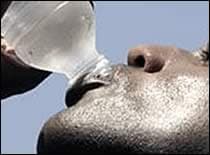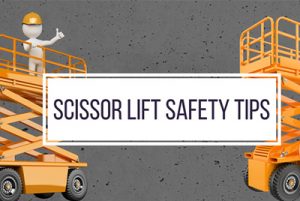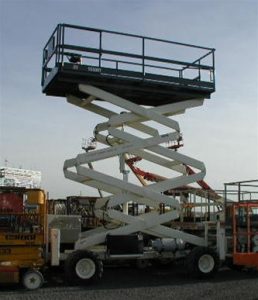Hydration & Scissor Lift Safety

It is very important to stay hydrated while working out in this heat & our safety crew tries to make sure that happens!

Drink Plenty of Fluids: Drink more fluids, regardless of how active you are. Don’t wait until you’re thirsty to drink.
- Warning: If your doctor limits the amount you drink or has you on water pills, ask how much you should drink while the weather is hot.
- Stay away from very sugary or alcoholic drinks—these actually cause you to lose more body fluid. Also avoid very cold drinks, because they can cause stomach cramps.
Replace Salt and Minerals: Heavy sweating removes salt and minerals from the body that need to be replaced. A sports drink can replace the salt and minerals you lose in sweat.
- If you are on a low-salt diet, have diabetes, high blood pressure, or other chronic conditions, talk with your doctor before drinking a sports beverage or taking salt tablets.

Scissor lifts are work platforms used to safely move workers vertically and to different locations in a variety of industries including construction, retail, entertainment and manufacturing. Scissor lifts are different from aerial lifts because the lifting mechanism moves the work platform straight up and down using crossed beams functioning in a scissor-like fashion. Although scissor lifts present hazards similar to scaffolding when extended and stationary, using scissor lifts safely depends on considering equipment
capabilities, limitations, and safe practices.
Safe use of scissor lifts
Only trained workers should be allowed to use scissor lifts. Safe scissor lift use includes properly  maintaining the equipment, following the manufacturer’s instructions, providing workers training and needed personal protective equipment (PPE), and implementing safe work practices. OSHA’s investigations found that most injuries and fatalities involving scissor lifts were the result of employers not
maintaining the equipment, following the manufacturer’s instructions, providing workers training and needed personal protective equipment (PPE), and implementing safe work practices. OSHA’s investigations found that most injuries and fatalities involving scissor lifts were the result of employers not
addressing fall protection, stabilization, and positioning.
Fall protection
Scissor lifts must have guardrails installed to prevent workers from falling (see 29 CFR 1926.451(9) or 29 CFR 1910.29(a)(3)(vii)).
When using a scissor lift, you should:
• Check to see that a guardrail system is in place before working on the scissor lift.
• Only stand on the work platform; never stand on the guardrails.
• Keep work within easy reach to avoid leaning away from the scissor lift.
Stabilization
Employers should ensure that scissor lifts are stable and will not tip over or collapse.
Here are some safe work practices to ensure safe, stable conditions for scissor lift use:
• Follow the manufacturer’s instructions for safe movement. This usually rules out moving the lift in an
elevated position.
• Isolate the scissor lift or implement traffic control measures to ensure that other equipment cannot
contact the scissor lift.
• Select work locations with firm, level surfaces away from hazards that can cause instability (e.g., drop-offs, holes, slopes, bumps, ground obstructions, or debris).
• Use the scissor lift outside only when weather conditions are good. Scissor lifts rated for outdoor use are generally limited to wind speeds below 28 miles per hour.
Positioning
Positioning the scissor lift to avoid crushing or electrocution hazards is important for safe use. Crushing hazards are present in workplaces using scissor lifts and may expose workers nearby, even those not
working on the scissor lift. Scissor lifts present crushing hazards similar to vehicles and other mobile
equipment at work sites.
You should be watchful when:
• A moving scissor lift is near a fixed object.
• A moving vehicle and the scissor lift are operating closely.
• The scissor lift passes under a fixed object, such as a door frame or a support beam.
Positioning the scissor lift to avoid electrocution, arc flash, and thermal burns is important for safely using scissor lifts near energized power lines. Since electricity can arc or jump from the power line to the scissor lift or worker, electrocution can occur even if neither the scissor lift nor the worker touches the power line.
Your employer should use the following work practices to ensure that scissor lifts are safely positioned:
• Implement traffic control measures around the scissor lift to prevent other workers or vehicles from getting too close.
• Use ground guides when operating or moving the scissor lift around the workplace.
• Select work locations that have at least 10 feet of clearance from electrical power sources (e.g., power lines, transformers) and that do not pose other overhead hazards (e.g., other utilities, branches,
overhangs, etc.).
• If the job task requires work near an electrical source, ensure that the worker is qualified and has received the required electrical training.
